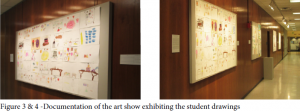Kaled Ostraff and Professor Dan Barney, Art Education Visual Arts
Introduction
My project’s aim was to apply Piaget’s cognitive developmental theory to art education. His theory describes the process children use to create views or schemas of the external world. He was “intrigued with the reasons children gave for their wrong answers” (McLeod, 2012). I was interested in analyzing drawings of children from two different cultural sites. To investigate what impact culture and the experiences of children have on the development of those children’s schemas as expressed through their drawings. I went to two sites: Summit Academy in Utah and Sylvia Park School in New Zealand.
Methodology
Piaget’s cognitive developmental theory describes the process that children use to construct views or schemas of the external world. This process is dependent on the experiences of the individual. For example, a child may see a bird flying and create a schema that flying objects are birds. The child then sees a plane that is flying and thinks it is a bird. The child has not yet experienced a plane so they have no schema for it. I had students draw pictures of what they thought an African Jungle was like. I was also interested in seeing how culture is displayed in children’s drawings. I addressed this by asking students to draw what food they would bring to a party, celebration, or feast. I Started in May by working with Summit Academy in Utah. In June I traveled to New Zealand and spent several days visiting Sylvia Park School and working with the art specialist. I went to several classes and gave them the same drawing prompts as the school in Utah. After the students in both locations were finished with their drawings, I analyzed the drawings looking for the students’ cultural views and personal experiences. I documented my observations in my field journal, as well as experiences from working with the students. These were used to inform my own teaching practices. I then applied for and installed an art show in the Harris Fine Art Center on Brigham Young University. The show allowed me to share the artworks with other art educators and to have discussions of the role of culture in development of children as expressed in their art.
Results
The students produced drawings that responded accurately, according to their view, to the prompts given. I was able to see the cultural impacts on students views. For example, students drew pizza, cake, ice cream, and other sweets that definitely give a view of the culture of celebrations. It was interesting because for the most part the students’ drawings were similar between the two locations. There were slight differences in the food that they have at celebrations. There was a greater difference obsevered in the view of what a jungle would look like. Students in New Zealand had a more Polynesian influence and their jungles looked more like Polynesian islands or New Zealand.
Discussion
Culture and the experiences of students are central to their development. Through this project I have been able to see how every individual’s view of the world is true for them and is based on their experiences. I was able to have new perspectives on teaching and how to be a better art teacher in regards to understanding my students’ view points. For example, I noticed that many students were drawing tables of food from a funny perspective. I initially thought that their understanding of perspective was off, but then I realized they physically see the world from a different view because of their height. Maybe their drawing was correct for their view point. In regards to my original question, yes, culture does impact students schema and these can be seen in students drawings.
Conclusion
When I proposed this project I wanted to study the impacts of culture of the development of schema. I feel I accomplished that goal, but learned so much more. These experiences have altered the way I interact with students and have helped me to see it is possible to have multiple coexisting realities at one time. As a teacher I have my views based on my experience, but so do my students. Their views and experiences are just as valid as mine. Being aware of these can lead to discussions and greater understanding of my students.



